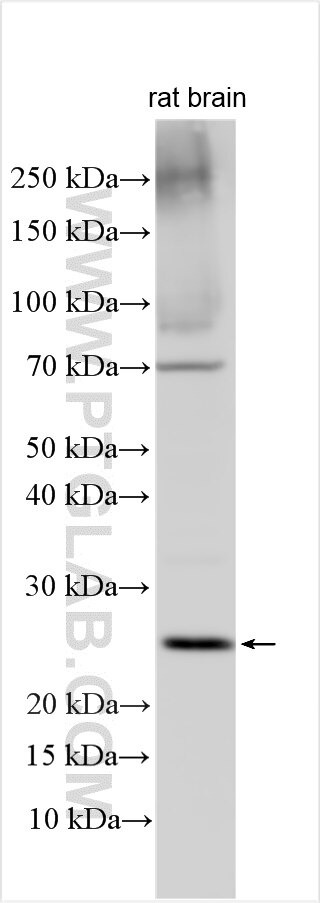PGLYRP1 Polyklonaler Antikörper
PGLYRP1 Polyklonal Antikörper für WB, ELISA
Wirt / Isotyp
Kaninchen / IgG
Getestete Reaktivität
human, Maus, Ratte
Anwendung
WB, ELISA
Konjugation
Unkonjugiert
Kat-Nr. : 18046-1-AP
Synonyme
Galerie der Validierungsdaten
Geprüfte Anwendungen
| Erfolgreiche Detektion in WB | Rattenhirngewebe |
Empfohlene Verdünnung
| Anwendung | Verdünnung |
|---|---|
| Western Blot (WB) | WB : 1:500-1:1000 |
| It is recommended that this reagent should be titrated in each testing system to obtain optimal results. | |
| Sample-dependent, check data in validation data gallery | |
Produktinformation
18046-1-AP bindet in WB, ELISA PGLYRP1 und zeigt Reaktivität mit human, Maus, Ratten
| Getestete Reaktivität | human, Maus, Ratte |
| Wirt / Isotyp | Kaninchen / IgG |
| Klonalität | Polyklonal |
| Typ | Antikörper |
| Immunogen | PGLYRP1 fusion protein Ag12690 |
| Vollständiger Name | peptidoglycan recognition protein 1 |
| Berechnetes Molekulargewicht | 196 aa, 22 kDa |
| Beobachtetes Molekulargewicht | 25 kDa |
| GenBank-Zugangsnummer | BC101845 |
| Gene symbol | PGLYRP1 |
| Gene ID (NCBI) | 8993 |
| Konjugation | Unkonjugiert |
| Form | Liquid |
| Reinigungsmethode | Antigen-Affinitätsreinigung |
| Lagerungspuffer | PBS mit 0.02% Natriumazid und 50% Glycerin pH 7.3. |
| Lagerungsbedingungen | Bei -20°C lagern. Nach dem Versand ein Jahr lang stabil Aliquotieren ist bei -20oC Lagerung nicht notwendig. 20ul Größen enthalten 0,1% BSA. |
Hintergrundinformationen
Peptidoglycan recognition protein 1 (PGLYRP1, also known as PGRP-S) belongs to a family of evolutionary conserved innate immunity proteins, which in mammals also include PGLYRP2, PGLYRP3, and PGLYRP4 (PMID: 17275309; 20418257). PGLYRP1 is highly expressed in polymorphonuclear leukocytes and to a lower extent in many non-immune cells (PMID: 20418257). It recognizes bacterial peptidoglycan and functions in antibacterial immunity and inflammation (PMID: 20418257). PGLYRP1 has been identified as a ligand for TREM-1 (PMID: 25595774).
Protokolle
| Produktspezifische Protokolle | |
|---|---|
| WB protocol for PGLYRP1 antibody 18046-1-AP | Protokoll herunterladen |
| Standard-Protokolle | |
|---|---|
| Klicken Sie hier, um unsere Standardprotokolle anzuzeigen |


